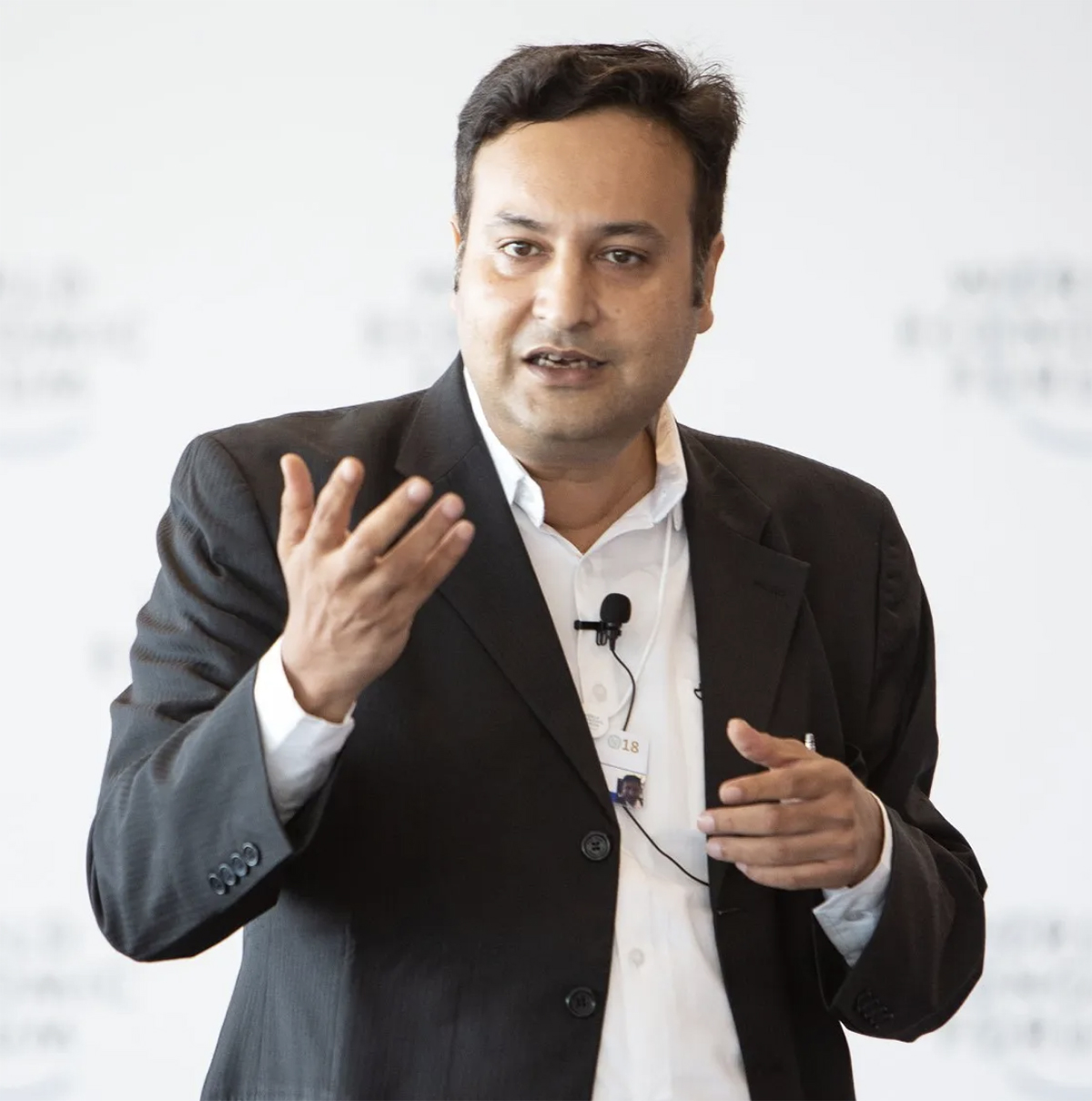March 22, 2023
No more should farmers of India be made to front the bill for agricultural innovation, now it is the policymakers' turn to take a risk, says Deepak Pareek in an exclusive interview.


Deepak speaking at Gulfood 2023
Make no mistake - when it comes to pulses, India is at the epicentre of production and consumption. Producing around 27 million metric tonnes of pulses annually, as of 2022, the global market is worth over $87 billion, and India accounts for a quarter of it.
Being a leader in the industry also puts the subcontinent firmly at the foreground of innovation, from the introduction of crop fertilizers at the beginning of the 20th century to the recent digital revolution with AgTech. According to AgFunder’s India 2022 AgriFood Startup Investment Report, investment in the sector has increased YoY exponentially, with startups bringing in a record $1.5 billion across 140 deals.
“Is there investment in AgTech? The answer is definitely yes,” said Deepak Pareek, the Chief Growth Officer at Suumaya Industries Limited, and AgTech consultant. “In the past four or five years we have seen roughly around one-and-a-half billion dollars put into the AgTech sector. And not just in India, when you extrapolate funding to South East Asia, you're talking about billions of dollars over a couple of years invested into India, Indonesia, Vietnam, and Thailand.”
The biggest AgTech companies in the region, including Absolute, CropIn, StellApps, TaniHub and Deehat, have received an influx of VC funding and attention from the fintech sector.
A common purpose shared between contemporary AgTechs involves strengthening the relationship between farmers and consumers, which involves providing farmers with the financial support to integrate new technology into their businesses. The AgTechs above have mostly fulfilled this goal through logistical means, handling the transportation demands of moving crops and commodities to restaurants, hotels and bulk buyers.
“Most of the funding that has been happening has been based in GMV’s (Gross Merchandise Value),” said Pareek. “AgTech has tried to follow the model of eCommerce - fifteen years ago we saw how companies who were not doing well financially have now become world leaders when it comes to market cap. AgTech has moved in this direction: rather than just helping a humble farmer, it would be better just to take care of the value chains.”
Value chains represent the surface level of the agriculture business, and just focusing investment in bolstering this system creates challenges of understanding between investors and farmers. “The three-six-nine mindset of three months of prototypes, six months of market testing, and nine months of scale-ups do not work in agriculture,” Deepak explains.
Agriculture is unique to other businesses because of the added risk brought about by abiotic factors. Climate change and an increase in fertilizer-immune pests can devastate a crop for a whole season. These complications, furthered by current economic restraints in trade have created a hesitant investor who will not succeed in the sector without understanding its complex needs first.
These needs become even more particular with pulses, as their leguminous production sets them apart from more easily grown cereals and grains.

Photo: ipopba, iStock
“Farmers are very different compared to the east and west, so when we start saying ‘farmers’ we reduce them to an entity that all think alike, but that is not the reality,” said Pareek. “Farmers in this part of the world [APAC region] have no choice, they are driven by the agenda of how they can ensure food for the rest of the world and not going to bed hungry themselves. They don’t choose, they just execute.”
If the last decade of global legislation has enforced anything, it is that pulse production will have to increase tenfold to meet the economic and social needs of the world. For India, the demand for exports is expected to increase at an annual rate of 10%, with an added increase in consumption.
With 20% of the Indian agricultural landscape used for the growth of pigeon peas, chickpeas, and green gram, all respectively facing the brunt of fluctuating inflation and export costs, the brunt of this supply and demand is felt most by farmers.
“The 300 million farmers in Asia, who are very important to the food security of the world, as well as the 100-odd million farmers in Africa, they are as important in food security as any other farmer in the west,” said Pareek. “The problem for these farmers is that when we first came to them in the 1960s, we said to them hey, we will increase your incomes and make your production more efficient by getting the green revolution going, and this farmer agreed and started using fertilizer. After another ten years, we said the cost of cultivation has increased, but now we’re finding uric acid in the formula and through the green revolution I have pushed you toward monocropping and using a lot of fertilizer, and now the immunity of your crop is down. So now that you're having pest infestation, you should be using pesticides.”
“With crop protection, you need more. So in the late 70s, we promised farmers that by using pesticides they will be even more efficient. They used it and the cost of cultivation increased and again the output cost did not increase substantially, so the farmer ended up poorer than what they were before the green revolution.”
Even the introduction of mechanized technology into Indian agriculture did not, as Pareek points out, make a substantial difference to the livelihood of farmers. With genetic editing and Aritificial Intelligence (AI), we have arrived at the tech revolution, and farmers have a right to be apprehensive.
“Now farmers want to see the value, you show me and you prove it to me then I am ok to spend the money and adopt it. So, the challenge with the current solutions is that they are just presentations for investors.”
According to a 2020 EY report, penetration of AgTech in India falls at around 1%, whilst NASSCOM, an Indian NGO, estimates the number to be 2%. The levels of adoption of different types of tech differ, with internet access becoming more available in semi-urban areas.
The farmers are the weakest link in the value chain, making them the most financially insecure when a new technology circulates. AgTech is still in its nascent period, and time is needed to present the fruits of its labour to farmers for them to get fully onboard.
Pareek proposes a radical outlook on AgTech and the responsibilities of Indian policymakers. An advisor himself to the government, Pareek says “we as a society will be forced to bring technology to the farmer. The government will not be able to sit on their chairs and think that farmers will take the risk.”
To attain this trust, Pareek proposes a radical outlook on AgTech and the responsibilities of Indian policymakers. An advisor himself to the government, Pareek says “we as a society will be forced to bring technology to the farmer. The government will not be able to sit on their chairs and think that farmers will take the risk.”
“Five years down the line, every corporation and conglomerate in agriculture, and consumers like you and me, we will front the bill for technology adoption because we will not have an option. A billion people are food insecure, we are already seeing the effects of inflation. Governments will be pushed.”
From a legislative standpoint, progressive policies must be implemented to incentivize farmers to adopt new tech. As the demand for pulses is now global, policy around tech needs to consider the financial benefit for farmers who need to save money whilst feeding an international customer.
“[In India] We import a lot for the simple reason that there is a disbalance of what we produce and what we consume. The consumer will need to learn that substitutions need to happen at the same time,” explains Pareek. “More countries should try to localize within the region and create sufficient availability. For example, Bangladesh is importing chickpeas from Australia. India does grow chickpeas, so can we look at it from a holistic and regional level? A lot of lentils come from Canada, but in India, Nepal, Bangladesh and Pakistan, we do have capacities and agroclimatic zones where lentils can be produced.”
The South Asian subcontinent carries a large percentage of the world's poor and undernourished. Demand for pulses is not just a global issue but a regional one, and to keep pulse prices from inflating and having to rely on international imports, countries within the region must work together. Advances in AgTech may be a component of cost-effectively optimizing production. What needs to be prioritized in tech and policy, however, is how innovations meet the acute needs of South Asian farmers.
The South Asian subcontinent carries a large percentage of the world's poor and undernourished. Demand for pulses is not just a global issue but a regional one, and to keep pulse prices from inflating and having to rely on international imports, countries within the region must work together.
“When we talk about simulation using AI and Machine Learning (ML) of new varieties of either genetically modified or genetically edited, both are very different because genetic editing, especially SDN-1 and SDN-2 does not add any extra genus DNA component to the crop, so they are, currently, a lot safer. Even a country like India, which is quite conservative toward GMOs, has allowed genetically edited or CRISPR cas9 added to products, being SDN-1 and 2.”
“The cycle of developing novel breeding technology reduces substantially because you can use simulation. And when we dovetail AI and ML to the new variety of identification and discovery, that whole cycle of six years becomes two years.”
This slice in time would benefit India tremendously in meeting its sustainability goals and stabilizing the cost of its crops. Regarding trust, Pareek suggests blockchain as a digital means to optimize value chains and trust between tech companies and farmers.
“Every country is clear about what they want to import. Europe has very stringent rules and regulations when it comes to the quality and the possibility of toxins in the crop. All these problems can be solved in a blockchain environment to ensure that the flow of documents becomes smooth, that provenance is there, and to ensure that all parties trust each other because the digital trust is created because of the ecosystem.”
At the time of this interview, Pareek was in attendance with AgTech company Stellapps, both as an expert and a speaker, at the 2023 Gulfood exhibition in Dubai.
“Gulfood this time is larger than ever. After COVID, for the first time, the restrictions have been lifted, and people are just waiting to showcase their achievements.” Pareek was there to talk extensively about the digital revolution in agriculture and how technologies can change the game for India.
With blockchain and biologicals, accountability moves to the forefront, and all means of trade, quality, and cost are made available to all players. For the morale of tech companies and traders, storing information in this way makes their dealings and plans for pulses transparent to the farmers.
Transparency is a recurring issue in the Indian pulse market. By pushing new technology and providing financial support to facilitate penetration, farmers are given the incentive and confidence to move to digital production and usher in a new form of pulses farming.
Disclaimer: The opinions or views expressed in this publication are those of the authors or quoted persons. They do not purport to reflect the opinions or views of the Global Pulse Confederation or its members.